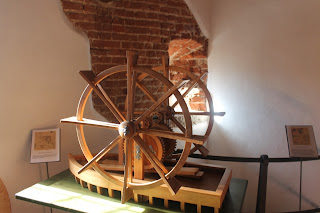The Ecomuseo de Roggia Mora - Mulino di Mora Bassa is something that doesn´t seem to fit in a blog titled Road of Faith & Art. If after reading this post, and looking at the pictures Estela and I took, you come to the conclusion, that this museum is not pertinent, I am confident you will at least find it to be a place with an interesting history and worth a visit.
After our visit to Vercelli, we drove 40 kilometers west to Vigevano, leaving the province of Piedmont, and into the neighboring province of Lombardia, in the county or Pavia.
We have written several posts on Vigevano in previous years.
Leonardo Da Vinci worked on several commissions in Vigevano, for the Duke of Milan, Ludovigo il Moro, during the final years of the 15th Centuries. One of his assignments was to improve the canals in the surrounding region.
From our perspective in Road of Faith & Art, one of Leonardo Da Vinci´s principal contributions was his Last Supper, a portrait of Our Lord and His Apostles. But Leonardo was mostly occupied more as an inventor, as a mechanical engineer, and than as a painter.
The Duke of Milan, Ludovigo il Moro, named the Moor because of his dark complection, gave this millhouse to Beatrice d'Este, in 1492, as a wedding present. When Beatrice died, in 1498, Ludovigo ceded the millhouse and all the surrounding properties to the Dominican Friars, of the Capella di Santa Maria delle Grazie, in Milan. In the refectory of the Capella, Leonardo da Vinci painted the Last Supper.
The Dominicans owned the millhouse over 300 years, until Napoleon expropriated it at the beginning of the 19th Century, when he invaded Northern Italy. The Marquis Saporiti renegotiated the millhouse and the rest of the Sforza inheritance from the Napoleon government in 1803, and it was ceded in turn to King Carlo Alberto of Piedmont, in 1845. The descendants of the royal family ceded the property 1988 to the Associazione Irrigazione Est Sesia (the regional irrigation administrator).
The Associazione Irrigazione obtained a grant in the year 2000, from the provincial government of Piedmont and the City government of Vigevano to restore the millhouse, converting it into a Museum dedicated to the role of the inner waterways of Piedmont and Lombardy, and the role Leonardo Da Vinci played.
The aim of the Associazione Irrigazione Est Sesia is to familiarize the general public with the canal system of the nearby plains of Piedmont and Lombardia, particularly the Roggia Mora, the Naviglio Sforzesco, the Naviglio della Martesana and the Canale Cavour canals.
When Estela and I visited the Ecomuseo della Roggia Mora Bassa, it was full of children from nearby grammar schools. Education in the European Union in general, and particularly in Italy, tends to integrate the world, while in America we seem to departmentalize knowledge.
In Europe, education offers young people a vision of the integrated relationship between history, literature, politics, engineering, environment and the community.
The Ecomuseo della Roggia Mora Bassa has entitled its permanent exhibit "L'Acqua disegna il paessaggio" ("Water designs the landscape"). Water is a key ingredient of a civilization.
When we go through the codices of Leonardo, we realize that many of the drawings of the machines were not intended as projects to be built, but to visualize a principle for his own personal study, or perhaps to be discussed with his colleagues and associates.
The inventions in the permanent exhibit of the Ecomuseo are all made in wood, based on the designs of Leonardo Da Vinci.
The above video shows how one of the wooden
models works, based on a drawing of Leonardo
referred to as the "Scythed Chariot".
The models work, and can be touched by visitors of the museum, adults and children alike.
The different wooden models show the diversity of the inventiveness of Da Vinci: weapons and gears, tools and clocks, boats and flying machines. All brought back to life in the atmosphere of the close of the 15th Century, at a moment of history when a new world had just been discovered.
Cecilia Gallerani, whose portrait was painted by Da Vinci, "The Lady with an Ermine", spent many a day here with the inventor in this millhouse. Cecilia was the favorite mistress of Ludovigo Sforza, and their relationship became intimate, and she bore il Moro a son, Cesare.
When Ludovigo married Beatrice d'Este, the duchess ordered her husband to banish Cecilia from the court and the Castle.
Giant crossbow, intentioned for destroy walls
of castles.
The Ecomuseo has a permanent exhibition titled "Leonardo in the Territory, the places, the studies, the machines." The models made in wood, were built by Gabriele Niccolai, from Florence, and Dario Noe di Bienale, Milan, at the beginning of the 21st Century.
To achieve this objective, Niccolai and Noe studies the drawings of Leonardo Da Vinci. The original drawings are in different collections, in several countries. These collections are called "codices".
The most important codices for these instruments are the "Codex Atlantica" and the "Codex Madrid". These codices show the variety of certain studies in mechanics, and a great graphical precision.




















































No comments:
Post a Comment